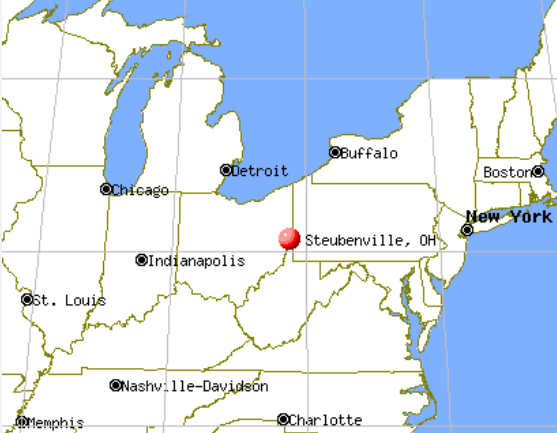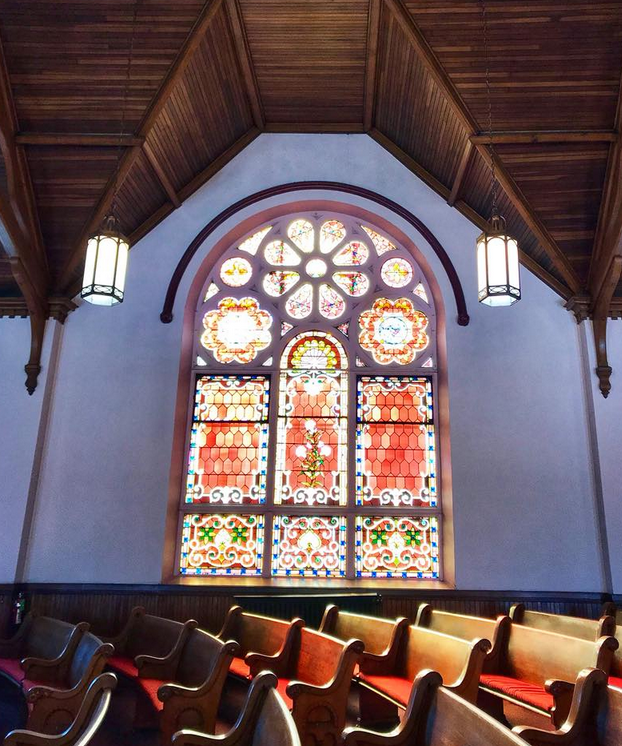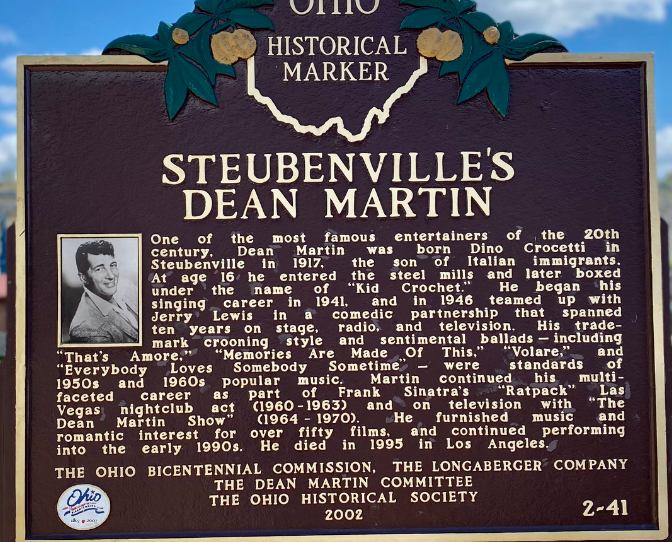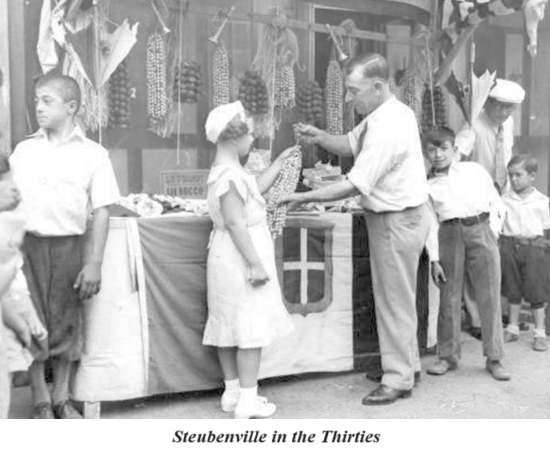
Frank Capra’s It’s a Wonderful Life (1946), arguably the best film Hollywood ever made, is set in fictional Bedford Falls, a steel-mill town in upstate New York with a large Italian population. George Bailey, a community-minded family man, operates the Buildings and Loan, which enables regular folks to buy homes. The likely future, going beyond the timespan of the film, is that the kind of community spirit that comes to the rescue of George Bailey on Christmas Eve 1945 will die out within a generation or two as the occupants of inner Bedford Falls depart for the suburbs—thanks, ironically enough, to the munificence of George Bailey’s Buildings and Loan.
Inner Steubenville, Ohio, is not Bedford Falls but during the post-war years it too was a thriving mill town with a strong Italian contingent. The main street in Bedford Falls is Genesee Street, approximately 300 metres long and the site of thirty family-owned businesses, a grocery store, a bicycle shop, two cafes, a hotel, the Bailey Building and all the other requirements for a “wonderful life”. The main street in downtown Steubenville is Fourth Street and doubtless the spirit of George Bailey also dwelt there on Christmas Eve 1945. That spirit, however, had well and truly departed by the end of the 1980s. The miracle, then, is that a new community, conservative in nature, is today helping to restore life to inner Steubenville.
This essay appears in the latest Quadrant.
Click here to subscribe
Downtown Steubenville has seen better days. The two pre-First World War skyscrapers, if thirteen-storey buildings can be called skyscrapers, are a testament to that. Nowadays most of the office space is unused. Fourth Street has a post-apocalyptic feel about it—disused commercial buildings, broken windows, an inoperable bridge to West Virginia, boarded-up houses and empty lots, plenty of empty lots. Everywhere in Steubenville, if you know where to look, are the phantoms of the past, including—yes—an opera house. There was also The Hub, a multi-storey department store on Market Street (adjacent to Fourth Street). The Hub (1940 to 1980) once enjoyed a reputation for unparalleled service throughout the Ohio Valley. It meant there was no need to frequent the department stores of Pittsburgh; as a consequence, bus services into Steubenville operated from every direction in the region.
No more. The downward trajectory of Steubenville, childhood home of Dean Martin, is one illustration of the post-war American Dream gone awry. Fifteen years ago, according to a local, you only visited inner Steubenville if “you wanted to get yourself murdered”. David Voght, now in his thirties, described Steubenville of that time as the  scary place he and his teenage friends from neighbouring towns frequented only in order to buy drugs. The danger was not so much the police but being mugged. Today, pointedly, David provides the music for the flourishing Sycamore Centre on Fourth Street, where Evangelicals have taken ownership of a beautiful old church (right) once belonging to Methodist-Episcopalians.
scary place he and his teenage friends from neighbouring towns frequented only in order to buy drugs. The danger was not so much the police but being mugged. Today, pointedly, David provides the music for the flourishing Sycamore Centre on Fourth Street, where Evangelicals have taken ownership of a beautiful old church (right) once belonging to Methodist-Episcopalians.
It was not that long ago, historically speaking, that Steubenville was a boom town. Few of those who witnessed the famous Dean Martin welcome-home motorcade along Fourth Street and Market Street in 1950 could have imagined what lay in store for not only Steubenville but the small manufacturing towns and family-owned farms in its vicinity. Dean Martin, at the time the most famous entertainer in America along with his sidekick Jerry Lewis, could hardly have imagined that The Hub (where his father managed the barber shop) was destined to be demolished and replaced by The Dollar Tree, today’s no-frills discount store. There are unconfirmed tales of not only “The King of Cool” but his Rat Pack friend Frank Sinatra turning up in Steubenville later in the 1950s. It is not impossible because a seamier side of the history of Steubenville is that it was a major bootlegging, speakeasy and gambling locale during the Prohibition era (1920 to 1933), gaining the reputation in some quarters as “Little Chicago”. Almost all of the original croupiers hired in Las Vegas, which legalised casino gambling in 1931, are said to have previously worked in the illegal gambling venues of Steubenville, since they were the only Americans with the requisite skill set.
But it was wartime industrialisation, rather than the gambling business, that rescued the Ohio Valley from the  Great Depression. Pittsburgh, just across the Ohio stateline in Pennsylvania, was referred to by some as the “arsenal of democracy”. A century earlier, James Parton described the dirty and smoky city of Pittsburgh less flatteringly as “hell with the lid taken off”. By the 1940s and 1950s, the city was dirtier and smokier than ever, and the locals often found themselves enveloped in pea-souper fog. To escape it all, at least for the weekend, Pittsburghers might motor an hour or so down the road to Steubenville with its smaller population and cleaner air, famous department store, numerous cinemas and three theatres. Producers often trialled a new show in Steubenville before taking it to Broadway—any number of famous musicals were premiered on Fourth Street. Sometime in the 1950s, though, the southern shores of Lake Erie replaced “Little Chicago” as a driveable weekend getaway.
Great Depression. Pittsburgh, just across the Ohio stateline in Pennsylvania, was referred to by some as the “arsenal of democracy”. A century earlier, James Parton described the dirty and smoky city of Pittsburgh less flatteringly as “hell with the lid taken off”. By the 1940s and 1950s, the city was dirtier and smokier than ever, and the locals often found themselves enveloped in pea-souper fog. To escape it all, at least for the weekend, Pittsburghers might motor an hour or so down the road to Steubenville with its smaller population and cleaner air, famous department store, numerous cinemas and three theatres. Producers often trialled a new show in Steubenville before taking it to Broadway—any number of famous musicals were premiered on Fourth Street. Sometime in the 1950s, though, the southern shores of Lake Erie replaced “Little Chicago” as a driveable weekend getaway.
Today Pittsburghers would never dream of spending their precious weekends in Steubenville. You might not get yourself murdered in Steubenville—in 2023, for instance, there were no homicides in the town—but gone are the cinemas, theatres and restaurants of old. And no local department store. Steubenville has its suburb, up the hill from the old downtown precinct, but little distinguishes it from other suburbs, apart from the Franciscan University. The local Walmart is enormous, but nobody is going to drive all the way to Steubenville to shop in “Wally World”.
So why did it go pear-shaped for Steubenville and all those other towns and communities in the American hinterland? Why has the heartland of America been hollowed out? The quick—and a little too simplistic answer—is China’s accession to the World Trade Organisation (WTO) in 2001, the economic model that is Walmart serving as a case in point. In Australian terms, the place is a K-Mart and a Coles combined with a Liquorland and a gun shop. Apart from the alcohol, the guns and the long aisles of sugary cereals, salty snacks and sickly soda, most of the merchandise comes from China. The Walmart staff are notoriously lowly paid and doubtless depend on food stamps to make ends meet; meanwhile, American companies and their shareholders profit from outsourcing jobs to China where workers earn even less than their counterparts in the United States. China’s membership of the WTO has made some American investors and entrepreneurs enormously wealthy but has been a disaster for American workers and family-owned farms. We can only imagine the bemusement the management at Steubenville’s Walmart would experience if a local producer asked to them to stock their eggs, vegetables, flour or meat.
Wendell Berry’s The Unsettling of America, published almost half a century ago, is a seminal work on the theme of American-style localism. Berry famously critiqued the decline of the family farm from the 1950s due to the growth of high-tech agribusinesses. By 1969, more than 650,000 Americans a year were leaving rural communities to find work in the cities, and that number continued to grow. Statistically, this new revolution increased the efficiency of agricultural produce. But it also devastated rural communities. If The Unsettling of America was a warning about the dangers of the decline of the family farm, Berry’s more recent tome, The Need to be Whole: Patriotism and the History of Prejudice (2020), reads like an angry denunciation. It is a Jeffersonian notion, writes Berry, that people who can take pride and ownership of their work—running a family farm, for instance—are more likely to experience a love of the homeland in the sense of a fulfilling patriotism. Contemporary America, by contrast, is ruled by a liberal elite “that defined itself as exclusively urban, and thus was content with its enrichment by the economic ruin of rural America”. If “the practice of neighbourhood” is what makes life liveable, as Berry asserts, the very theme of Capra’s It’s a Wonderful Life, then how to make that happen in a modern economy which privileges profit over community?
One answer, argues Berry, is to overcome the American prejudice against physical work. Controversially, in the minds of some, Berry sees the demarcation between labour and management as the enduring legacy of the era of slavery (1620 to 1863) rather than race. He further notes, in The Need to be Whole, that the same writers who bemoaned the dramatic decrease of black family-owned farms in the South between 1950 and 1975, when African-Americans moved in number to Chicago, Detroit and other northern cities, failed to mention that the same trend applied to all farmers. “This, I believe, is because the prejudices against farmers and farming and farms are unrecognised.” Few urban Americans, in the opinion of Berry, care about the fate of the family farm—and its local community—since they are preoccupied with the consumerism, entertainment and technology of urban existence, a vision of the good life somewhat at variance with the one Thomas Jefferson had in mind. For the beneficiaries of agribusiness—for instance, the owners of Walmart, the vendors in Walmart and the patrons of Walmart—what goes on in rural America stays in rural America. Before Covid, at least, not even the fact that Chinese investors owned an estimated 192,000 acres of US agricultural land valued at $1.9 billion managed to grab the attention of Americans. By 2023, according to one report, that figure had risen to 380,000 acres, but legislators were more concerned about Chinese investors recently buying a disused US Airforce base. Leaving aside, again, the issue of national security, what the wholesale purchase of farmland/agribusinesses across the American hinterland represents—and fifteen other foreign countries rank higher than China on that score—is the demise of the family-owned farm in favour of rural corporate entities and wage-slavery. This, at any rate, is Berry’s narrative.
Commentators, both Left and Right, have disparaged their compatriots in the hinterland, farmers or otherwise. Berry cites New York Times columnist Paul Krugman who claimed in a November 2018 article, “Real America Versus Senate America”, that the American metropolis was now the “real America”, being cosmopolitan, highly educated and “racially and culturally diverse”. Rural America, in sad contrast, was not only “still very white” but overrepresented by “non-college whites”. Kevin Williamson, two years later in the right-wing but anti-Trump National Review, said much the same, albeit a little more brutally:
If you spend time in hardscrabble, white upstate New York, or eastern Kentucky, or my own native West Texas, and you take an honest look at the welfare dependency, the drug and alcohol addiction, the family anarchy—which is to say, the whelping of human children with all the respect and wisdom of a stray dog—you will come to an awful realization … The truth about these dysfunctional, downscale communities is that they deserve to die.
Williamson’s point, ultimately, is that those who live in America’s hinterland need to follow the new economy and, after hiring a U-Haul moving truck, get themselves to New York or Los Angeles or San Francisco where the jobs are. The alternative to “mobility” was oblivion in one form or another.
The quiet social experiment taking place in Steubenville today challenges such assumptions. The cost of living has played a role in that. John Kuhner, who writes for First Things magazine, always liked the fact that in any reasonably sized American town you could find at least one well-stocked antiquarian shop; so, when the aged owner of Book Marx bookstore in Fourth Street offered to sell him his store at a knockdown price, Kuhner accepted. Sales are helped not only by the presence of the Franciscan University in the suburbs of Steubenville but the growing number of new arrivals in town from all over the country. Kuhner himself was born and raised in New York, a city that is now too expensive for him and his wife and their five children. He is not alone: the Empire State’s population, according to the Census Bureau, declined by 631,104 to 19,571,216 between April 2022 and mid-2023.

The exodus from New York and California in favour of states often ridiculed as “fly-over territory” is not only a function of the cost of living. The effect of Covid and the trend towards working online from home has made moving to a “downscale” city such as Steubenville an option. An engineer and an architect, recent arrivals in town with whom I spoke, both earn their living by providing products for clients who live on the other side of America. But cost is only one factor at play. Roger L. Simon’s American Refugees: The Untold Story of the Mass Migration from Blue to Red States (2024) chronicles the consequences of ordinary Americans living in cities run by Democrat apparatchiks in the grip of PC madness. In San Francisco, for example, looting—regarded by Black Lives Matter and their allies in government as a “redistribution of wealth”—means even the most upscale suburbs of “the Paris of the West” are unsafe. Perhaps defunding the police force was not such a brilliant idea after all. And there are the thousands of homeless—sorry, unhoused—people permitted to live on the streets, a danger to themselves as much as to the locals. Not the ideal environment for raising a family. And, on the other side of the continent, the decision by Manhattan’s Judge Arthur Engoron to fine Donald Trump $355 million for a victimless financial “crime” has only increased the certainty that progressivism has become a form of suicide—economic, social, political and civilisational. This is how famed investor and Shark Tank celebrity Kevin O’Leary responded to Engoron’s adjudication:
I don’t do business in New York because it’s a loser state. It has bad policy, high taxes, it’s mismanaged, and it does this kind of thing. This is a loser state, Massachusetts is a loser state, New Jersey is a loser state. I do business in places like North Dakota, Oklahoma, West Virginia, Florida, Texas. These are winner states.
Though Steubenville is literally across the Ohio River from West Virginia—the connecting bridge, typically, has been out of action for almost a year—it is not the investment of a Kevin O’Leary that is luring newcomers there. Along with the inexpensive housing, something of a siren call has gone out to young parents—young Catholic parents, especially—to give the growing family-based community of Steubenville a chance. One family, for instance, migrated all the way from Alaska to the “new frontier” of Steubenville. Nobody seems entirely sure how the trend began, although some newcomers are returnees after studying at the Franciscan University when they were single. Steubenville’s evolving reputation as a haven for conservative families has also been enhanced by Matt Fradd’s Pints with Aquinas podcast, a conversational program about living out the Catholic faith in the modern world. The charismatic Fradd, who has an office in one of Steubenville’s unutilised skyscrapers, has a worldwide audience of millions and is always touting the advantages of community life in Steubenville.
No less important to the social revolution in Steubenville is the local team behind New Polity magazine. Marc Barnes, one of the founders of the journal and its most prolific writer, describes his political philosophy as “localist”. Barnes’s brand of conservativism is a long way from that held by Charles Wilson, president of General Motors in the early 1950s. Wilson, in a hearing before Congress to confirm him as Secretary of State for the Eisenhower administration, rejected the suggestion that a conflict of interest could arise between his role as the guarantor of GM shareholders and GM’s contracts with the US government: “I cannot conceive of one because for years I thought what was good for our country was good for General Motors, and vice versa.” If nothing else, reasons Barnes, the demise of steel mills and associated manufacturing along the entire Ohio Valley has destroyed the old belief that what is good for corporate America is necessarily good for America as a whole. What’s good for Wall Street, Big Pharma, Big Tech, and we could add Walmart, is often not good for regular Americans.
The largest city in the region, Pittsburgh, has survived the post-industrialisation era better than Steubenville and the other towns along the Ohio Valley. It has made the shift from a blue-collar steelworkers’ town to something of an arts centre. A case in point is the Andy Warhol Museum with its seven floors of gallery and exhibition space along with an education studio and conservation laboratory. Pointedly, it is housed in a building that previously served as a distribution operation for products sold to mills and mines. Pittsburgh is also a railway hub with connections to Chicago and San Francisco to the west and New York and Washington in the other direction. In contrast, freight trains rumble through Steubenville in the middle of the night but never stop. There is no longer a passenger service between Steubenville and Pittsburgh, which is to say there is no rail connection between Steubenville and the rest of America. Not even a bus goes all the way to Pittsburgh.
The one shop that has survived the modern-day apocalypse is the fabulous Downtown Bakery at the far end of Fourth Street. Opened in 1958 and today run by the children of its founders, the storefront faces what looks like a bombsite. This makes the presence of John Kuhner’s brilliant Book Marx bookstore halfway along “Historic Fourth Street” all the more miraculous. Matt Fradd has also put money into the precinct, helping to finance the new Chesterton and Co Cigars store right next door to Kuhner’s bookshop. Chesterton and Co is not just a grand cigar lounge but a genuine showpiece that Fradd and his business partner Rocco Palumbo restored and refurbished under the auspices of Steubenville Building Inspection Division. Here was the site of the legendary Herald Square Cigar Shop; the general manager Matt McCloskey speaks of customers keen to reminisce about the past: “They tell me stories of how they used to come in here when it was Herald Square with their fathers, grandfathers. They  would pick up a cigar and a newspaper.” Whatever one’s opinion of cigar lounges, the founding of Chesterton and Co represents an important act of historical continuity.
would pick up a cigar and a newspaper.” Whatever one’s opinion of cigar lounges, the founding of Chesterton and Co represents an important act of historical continuity.
The place next to Chesterton and Co is a discontinued sport store but the next site along is perhaps the jewel of Fourth Street: the Grocery Box (right). It is a humble enough establishment—the awning above the door still touts the previous occupant, a florist—and there is not enough trade yet to justify it being open for more than a few days a week. Nevertheless, Wendell Berry might rate this store as the most important of the new developments along Fourth Street. Owned by Marc Barnes, the Grocery Box has a policy of sourcing its stock—wheat, barley, eggs, honey, vegetables, fruit and so on—from local producers. Only if (say) cooking oil or butter cannot be locally supplied will he and his team look further afield, though almost always within the confines of Ohio. For the moment, at least, the Grocery Box cannot begin to compete with the vast array of competitively priced groceries available at Walmart. Nevertheless, the Grocery Box—a project only possible because of the incredibly low rentals in the downtown precinct—offers the promise of a market for local producers; in other words, Berry’s cherished freeholder, the self-governing individual or family cultivating a small estate with their own sweat and judgment.
Barnes’s notion of a self-governing American citizen is broader that Berry’s yeoman definition. It includes, for instance, self-employed tradesmen. This explains the motivation behind another brainchild of Barnes’s, the new College of St Joseph the Worker in Steubenville. An article in the Washington Examiner outlined the intent of the new college, which will open later this year with a hundred or so students:
Once students graduate from the Catholic College of St Joseph the Worker, they will have earned a bachelor’s degree in Catholic studies while becoming carpenters, electricians, masons, or heating, ventilating and air-conditioning technicians. In an effort to unburden students from debt, the cost of tuition for the three-year, in-person program in Steubenville is $15,000 a year, including housing. Students are paid a salary when they train, so they can graduate with the financial freedom to start their families and be productive members of their faith communities.
Barnes shares many of Berry’s beliefs about what characterises the good life: a loving family; the necessity of honest work that—however humble—involves pride and ownership; friendship; genuine community; stewardship of the land; and faith. Both Berry, a Protestant, and Barnes, a Catholic, view the world from a Christian perspective but both dislike the “Christian Right”. For the eighty-nine-year-old Berry, the entanglement between politics and religion is something of trap set by Republicans—he himself appears to have been a lifelong Democrat—with right-wing Christians promoting the profit-driven exploitation of America’s natural resources. The political philosophy that informs Barnes, no doubt influenced by the philosopher D.C. Schindler, author of The Politics of the Real: The Church Between Liberalism and Integralism, also distances itself from the kind of political Christianity we associate with (say) Prosperity Theology or economic rationalism.
However, Barnes would disagree with Berry that politics and faith need to be separated, believing this to be a product of “liberalism”, using that term in its broadest civilisational sense. That we have entered a “postliberal era”, argues Barnes, is exemplified by the emergence of progressive identity politics on the one hand and the Alt-Right on the other. Customary liberal constructs no longer satisfy. In both cases, people futilely attempt to comprehend and express their full humanity through the narrow lens of political identity. Our deepest and best selves, our true moral selves, should not be compartmentalised as “religion”—that is, something only activated on Sunday or in our private life—but, rather, ought to accompany us through the day, all day, every day. In short, and as I have noted before, we may find our identity through our humanity, not our humanity through identity.
It is not surprising, then, to find this line in the mission statement of New Polity: “The intellectual and the practical are therefore bound together in postliberalism. We must come to understand that we might act and act that we might understand.” A wonderful life, therefore, means always engaging with the world in a loving and charitable mode, of taking responsibility for our actions, of building self-supporting communities that do not look to the state or institutions of power to save them. Self-reliance, as the Amish long ago discovered, is the key to self-governance.
Marc Barnes might be embarrassed if I say so but the spirit of George Bailey is alive and well in his endeavours. Even the house he and his wife Maura own—on Fourth Street, of course—is reminiscent of the “drafty old house” that George (played by Jimmy Stewart) and Mary (Donna Reed) restore in It’s a Wonderful Life. If there is a major difference between George Bailey and Marc Barnes it is that the former had no clear political philosophy behind his acts of generosity and self-sacrifice. Consequently, his Building and Loan business, were it to survive the 1950s and beyond, would have ended up undermining the very kind of community spirit he revered. Reason enough, you might say, to think through the consequences of actions.
Daryl McCann, a frequent contributor, has a blog at https://darylmccann.blogspot.com. He wrote the article “No World Order” in the March issue
 Sign In
Sign In 0 Items (
0 Items ( Search
Search









Really interesting article thank you. I grew up in and lived in cities all my life but have always had affection for country towns and wondered how some of them can turn around from what looks like a deeper and deeper social and economic hole they are falling into. What is interesting is that Steubenville is reviving by the choice of people to restore and build a community deliberately, even if it means not always choosing the most economically advantageous option. I’m sure the uni helps, and there are precious few towns in Australia that have that kind of advantage – Armidale maybe – but it still show it could be done. But is the Catholic commitment central here, or could a secular population do the same? Beauty is important to any town revival – people want to see country beauty and they want to live in it. More modern style buildings just won’t cut it.